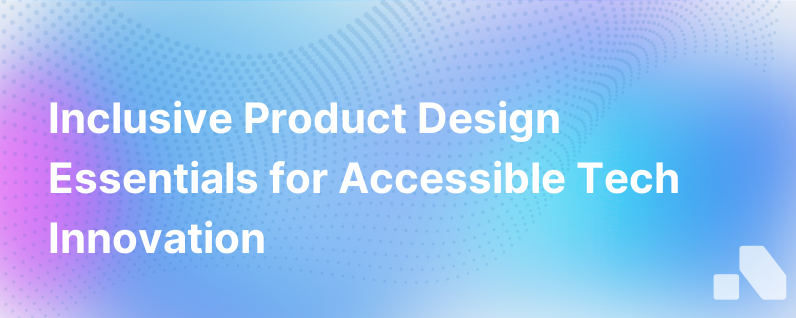
Inclusive product design is not just a noble goal; it is an essential pursuit to ensure that the technology we develop serves as many people as possible, bridging gaps across various user capabilities and backgrounds. In the process of creating more accessible technology, product designers and developers have the power to profoundly impact the user experience and accessibility for individuals of all abilities.
Immersing ourselves in the world of inclusive product design exposes us to a diverse universe of user needs. Yet, in many cases, the technology developed often caters to a narrow segment, sidelining those who don't fit the profile of the 'average' user. As industry professionals and champions for progress, how do we shift our paradigms to embrace and cater to a broader spectrum of humanity?
Here are three critical tips to embed in the DNA of your product development process to ensure accessibility takes center stage, not as an afterthought but as an intrinsic part of the design ethos.
1. Start With a Foundation of Empathy and Awareness
To design inclusively, start by understanding the spectrum of potential users. This requires empathy — an effort to understand people's experiences, challenges, and needs, particularly those different from your own.
Participatory Design
Involve a diverse group of users early in the design process. Soliciting direct feedback from people with disabilities (visible and invisible), various age groups, different cultural backgrounds, and a range of technical proficiency can offer insights that are impossible to gain from simply relying on best guesses or stereotypes.
Accessibility Audits
Assessing products through accessibility audits conducted by experts can pinpoint barriers that might not be readily apparent. These audits use guidelines like the Web Content Accessibility Guidelines (WCAG) as benchmarks for creating accessible content.
Continuous Learning
Moreover, keeping abreast of the latest research in human-computer interaction, accessibility guidelines, and advances in assistive technologies is crucial. As norms evolve, so too must our understanding of how to best serve an increasingly diverse user base.
2. Embrace Universal Design Principles
Universal design entails the creation of products that are usable by all people, to the greatest extent possible, without the need for adaptation or specialized design. By embedding universal design principles at the core of product development, products become inherently more accessible.
Equitable Use
Designing for equitable use means making technology usable and marketable to people with diverse abilities. This isn't about creating separate but equal products; it's about having one inclusive product that serves everyone.
Flexibility in Use
Accommodating a wide range of individual preferences and abilities is crucial. This means building in flexibility — like adjustable font sizes for users with low vision or multiple methods for navigation for users with motor disabilities.
Simple and Intuitive
Creating products that are easy to understand, regardless of a user's experience, knowledge, language skills, or current concentration level, is a strengthening element of an inclusive design approach. An interface that is intuitive to navigate for various cognitive levels is vital.
Tolerance for Error
Designs must minimize hazards and adverse consequences of unintended actions. By implementing tolerance for error, we ensure the technology safely caters to users who may make more mistakes due to a wide range of reasons, from motor disabilities to cognitive differences.
3. Design for Accessibility From the Outset
Embedding accessibility into the design process from the beginning is more effective, both in product outcome and cost, than trying to retrofit accessibility features after the fact.
Build Inclusive Design into Your Workflow
From the drafting table to the final quality assurance, accessibility considerations should be interwoven into each phase of the product development process. It must be a staple, not a side dish, served up during each phase of the process.
Accessibility as a Key Performance Indicator (KPI)
Incorporate accessibility metrics as part of the product's success criteria. By evaluating products against clear accessibility KPIs, there's an objective measure upon which to base improvements.
Leveraging Technology to Enhance Accessibility
We have an array of technologies at our disposal that can help make products more accessible. Voice recognition and natural language processing can aid users with motor impairments, machine learning can tailor experiences to individual needs, and virtual reality (VR) can create simulations to test accessibility in ways physical prototyping cannot.
Documentation and Communication Clear, comprehensive documentation that addresses accessibility features helps both users and developers alike. Communicate the presence of these features explicitly and ensure that guidance on how to use them is easy to find and understand.
Conclusion
Building more accessible technology is an ongoing commitment that transcends the mere compliance with standards. It is a holistic journey that, when approached thoughtfully, sparks innovation and leads to the creation of products that resonate more deeply with a broader audience.
Inclusive design is not just ethically right but also makes excellent business sense: it expands market reach, drives innovation, and yields products that are not just for the few but truly for all. By fostering a culture of empathy, committing to universal design principles, and prioritizing accessibility from the start, product developers can usher in an era of truly inclusive technology.
Aomni thrives on the principle of inclusivity and accessibility in AI-powered B2B sales platforms. Our tools are designed with the understanding that each user brings a distinct set of needs and preferences, allowing sales teams to nimbly maneuver complex sales terrains with technology that is not only sophisticated but also accessible to all. We live by the credo that when technology is accessible to the widest range of people, business thrives and society progresses.